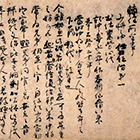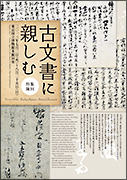Japanese Gallery (Honkan) Room 16
July 2, 2013 (Tue) - August 25, 2013 (Sun)
Historical Japanese documents usually include a sender and a recipient, or can be established as notices or descriptions of business affairs. Etiquette in documents has been valued in Japan from ancient times. According to the content, as well as the relationship between the sender and recipient, rules were established in everything from writing style to choice of paper and sealing method. Consequently, Japanese historical documents are mainly studied on themes such as style of composition and content, procedures and functions, as well as the connections between documents. The document material used, handwriting, ink color, writing style and brushwork, sealing method, and the provenance of documents are also research topics.
From the Heian period (794 - 1192) onward, documents were created using mainly Japanese types of paper, made from materials including mulberry bark fiber, gampi bush bark, and the Oriental paper bush. Recycled paper with the color of diluted ink can be seen in messages and speech drafts that court officials wrote for emperors. Paper was a precious commodity at the time, therefore when transcribing texts or writing diaries people also used the reverse sides of documents that were no longer required. Examples of these old documents written on the reverse sides of others have survived until the present day.
This exhibition aims to introduce Japanese historical documents through examples related to famous people and through distinctive documents characteristic of each time period. The exhibition forms a part of the publication of findings of the research project "Database of Tokyo National Museum Collections 'Historical Documents'," which receives funding from the Japanese government's Grants-in-Aid for Scientific Research.


